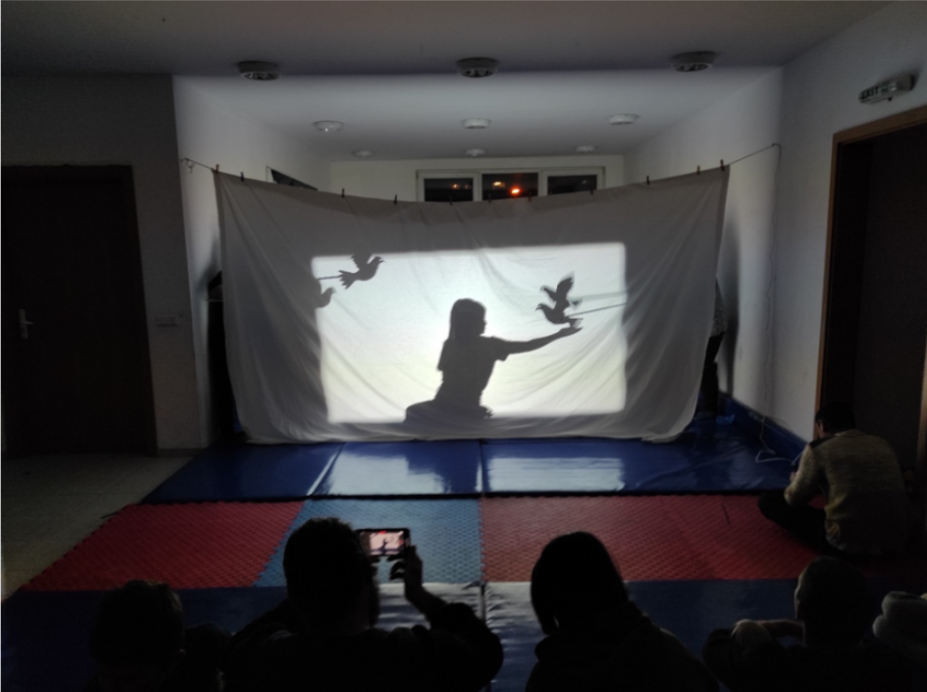SHADOW THEATER IN PRESCHOOL, SCHOOL, YOUTH, AND ADULT EDUCATION

The course is addressed to teachers in kindergartens and schools, youth workers, adult trainers, and art facilitators who want to become familiar with and employ this attractive art-based method in their work. It is suitable for engaging with representatives of various mainstream and disadvantaged groups in education and training, social work, civic engagement and participation, creativity and culture, and other areas of society.
METHODOLOGY
Shadow theater is a really simple and interesting form of art to perform and a very useful tool to provoke curiosity, creativity, and artistic expression. Everybody can play shadow theater. Chinese shadow theater uses figures made out of cardboard or other materials, but in this course we work mainly with the bodies/shadows of the participants. Participants in shadow theater plays may be from 5 to 85 years old. They may come from different segments of society. Usually, the course provider (VVI Foundation) makes shadow theater with non-professional actors, coming mostly from vulnerable groups. Through the means of shadow theater they convey powerful messages to the mainstream society about their problems of life situations.
Shadow theater is also very suitable for shy persons, because they do not face directly the audience. The white sheet hides them from the viewers, who see only the shadows (not the faces) of the real participants. This creates a sense of security for the performers and eases the communication flow between the actors and the audience.
In addition to playing with their own shadows, the course participants also experiment with lights (could be of different colors), perspective (different distances of the actors/props from the light source, which means different sizes of the images on the white sheet screen), settings (like slides projected on the screen, symbolizing a specific place where the plot is developing), etc. When appropriate soundtrack is added, the trainees come up with comprehensive performances (shadow theater miniatures) ready to be publicly presented. Thelearning process is all about that.
The training modules are designed to introduce participants to Shadow Theater as an expressive and inclusive form of performing arts, accessible to various users and audiences. For example, the creative process may involve professional, semi-professional, and, especially, non-professional actors, including kids in kindergartens, pupils in schools, young, adults and even senior persons, people with disabilities, residents of social institutions, etc. The course is based on 90-minute sessions (two per day), forming in participants basic skills to do shadow theater as a collective effort, revealing the creative potential of everybody involved in the process.
LEARNING OUTCOMES
Participants will:
- Get familiar with shadow theater as a tool for working with various social groups;
- Perform individual and group tasks related to shadow theater;
- Create shadow theater miniatures, cooperating with other trainees.
- Develop their own potential to stage shadow theater performances;
- Get inspiration to use shadow theater methods upon return at home to diversify the activities of their sending organizations.
LANGUAGE
The course will be entirely delivered in English.
REGISTRATION
Please, enroll here. A minimum of six participants is required for a course.
PROGRAMME
Activities include an introductory online meeting and 7 days face to face training in Sofia, Bulgaria, including two 90-minute sessions per day and preparation and staging of a final performance.
COURSE
Day 0
Arrival of participants.
DAY 1
Getting familiar with your shadow: walking on the rope exercise; playing with perspective in shadow theater.
DAY 2
Individual tasks: playing simple actions, professions, objects and animals.
DAY 3
Performing shadow theater tasks in duos and trios: situations and small plots.
DAY 4
Division into work teams, watching and discussion shadow theater videos, script work for a theatrical miniature, preparation of story boards; distribution of tasks within work teams (artistic and technical/support roles).
DAY 5
Team works: rehearsals of shadow theater miniatures.
DAY 6
General rehearsal of shadow theater miniatures and a public performance.
DAY 7
Feedback, assessment of training, plans for the future activities upon return to home, and departure of participants.


